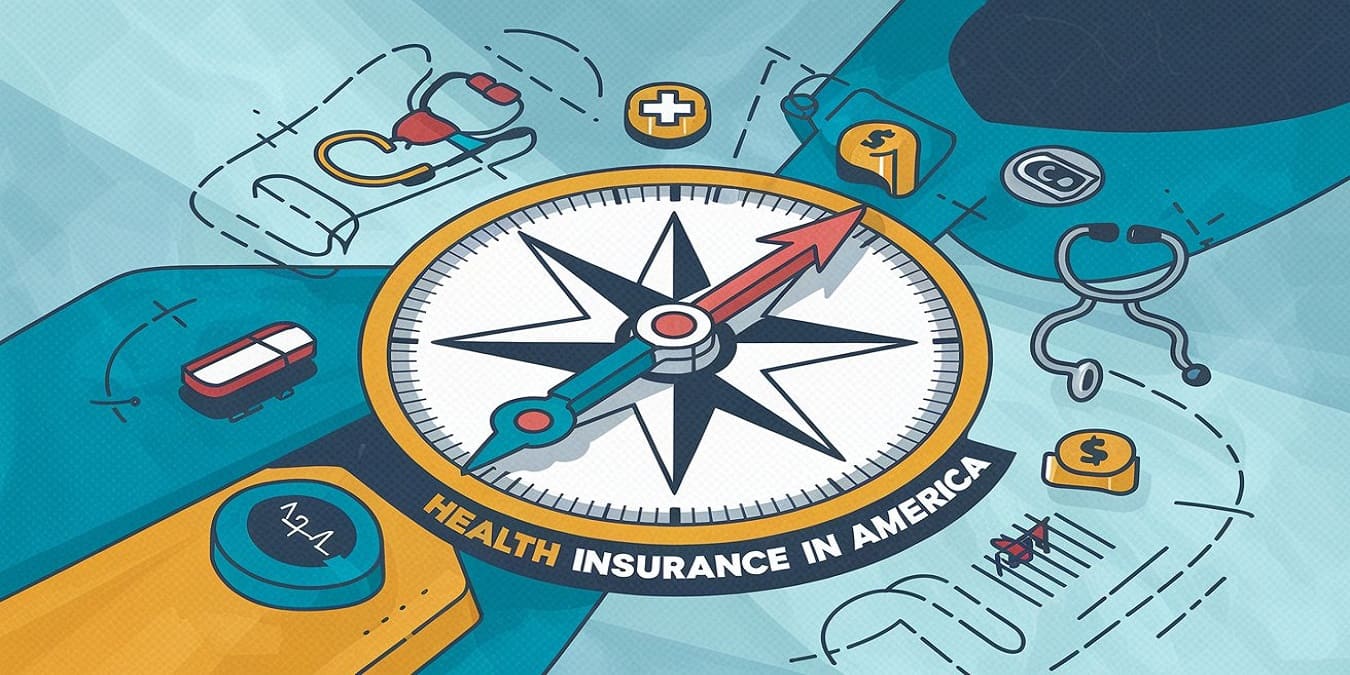
Health Insurance in America
You’ve probably heard it before: health insurance in America is complicated. Whether you’re signing up for the first time, switching plans or just trying to figure out what all those terms mean, navigating this labyrinth can feel overwhelming.
But here’s the good news, you’re not alone. Millions of Americans face the same challenges every year and with a little guidance, you can make informed decisions that work best for you and your family.
Understanding health insurance doesn’t have to be intimidating. In fact, once you break it down into manageable pieces, you’ll realize that you already have the tools to take control of your healthcare choices.
So, let’s dive in together and unravel the complexities of health insurance in America. By the end of this guide, you’ll feel more confident about making decisions that align with your needs and budget.
Why Is Health Insurance So Complicated?
Have you ever wondered why something as essential as healthcare comes with so many hoops to jump through? The truth is, the U.S. healthcare system is unique compared to other countries.
Unlike nations with universal healthcare systems, America relies heavily on private insurers, employer-sponsored plans and government programs like Medicare and Medicaid. This patchwork approach creates layers of complexity that can leave even the most savvy consumers scratching their heads.
One reason for the confusion lies in the sheer number of options available. From HMOs and PPOs to high-deductible plans and health savings accounts (HSAs), the terminology alone can seem like its own language.
Add to that the constant changes in regulations, premiums and coverage rules and it’s no wonder people feel lost.
But here’s an important question: What happens if you don’t understand your policy? Without clarity, you risk being underinsured, overpaying or facing unexpected medical bills.
That’s why taking the time to learn how to navigate these waters is crucial, not just for your wallet but also for your peace of mind.
Breaking Down the Basics: Understanding Health Insurance
Before we tackle the nitty-gritty details, let’s start with the fundamentals. At its core, health insurance is designed to help cover the cost of medical care. Instead of paying the full price for services like doctor visits, surgeries or prescription medications, you share the costs with your insurer.
Sounds simple enough, right? Well, there’s a bit more to it than that.
When you enroll in a plan, you’ll encounter several key components that determine how much you pay and what’s covered.
- Premiums : This is the amount you pay each month to maintain your coverage. Think of it like a membership fee.
- Deductibles : Before your insurance starts covering costs, you may need to pay a certain amount out-of-pocket. For example, if your deductible is $1,000, you’ll pay the first $1,000 of your medical expenses.
- Copayments and Coinsurance : Once you meet your deductible, you might still owe a portion of the bill. Copays are fixed amounts (like $20 per visit), while coinsurance is a percentage of the total cost.
- Out-of-Pocket Maximum : There’s a cap on how much you’ll pay annually. After reaching this limit, your insurance typically covers 100% of your eligible expenses.
Understanding these elements is critical because they directly impact your financial responsibility. If you choose a plan with low premiums but high deductibles, you could end up paying more upfront when you need care. On the flip side, higher premiums often mean lower out-of-pocket costs later.
Does this sound overwhelming yet? Don’t worry, we’ll explore strategies to simplify your decision-making process soon.
Types of Health Insurance Plans: Which One Fits You?
Now that you’re familiar with the basics, let’s talk about the different types of health insurance plans available in America. Each type has its pros and cons, depending on your lifestyle, budget and healthcare needs.
Employer-Sponsored Plans
If you’re lucky enough to have access to employer-sponsored health insurance, consider yourself fortunate. Many companies offer group plans that split the cost between you and your employer. These plans usually provide comprehensive coverage, but keep in mind that your options may be limited to what your company offers.
Marketplace Plans
For those without employer coverage, the Affordable Care Act (ACA) created state and federal marketplaces where individuals can shop for plans. These marketplace plans come in four tiers, Bronze, Silver, Gold and Platinum, each offering varying levels of coverage and cost-sharing.
While Bronze plans tend to have lower premiums and higher deductibles, Platinum plans offer richer benefits at a steeper monthly rate.
Government Programs
Medicare and Medicaid are two government-run programs designed to assist specific populations. Medicare primarily serves seniors aged 65 and older, while Medicaid provides support for low-income individuals and families. Eligibility requirements vary by state, so it’s worth checking if you qualify.
Private Plans
Some people opt for private insurance outside the marketplace. These plans can offer flexibility, but they may not provide the same subsidies or protections as ACA-compliant policies. Be sure to read the fine print carefully before committing.
So, which option is right for you? It depends on factors like your income, age, health status and whether you prefer broader networks or lower costs. Take some time to evaluate your priorities, it’ll make choosing a plan much easier.
Navigating Open Enrollment: Tips for Success
Open enrollment season is your chance to review and update your health insurance plan. But with deadlines looming and endless paperwork, it’s easy to procrastinate. Here’s how to stay ahead of the game.
- Start Early : Give yourself plenty of time to research options and compare plans. Rushing through the process increases the likelihood of mistakes.
- Know Your Needs : Reflect on your past year’s healthcare usage. Did you visit specialists frequently? Are you managing chronic conditions? Tailor your choice to fit your anticipated needs.
- Use Online Tools : Websites like Healthcare.gov and independent comparison platforms can help you filter plans based on criteria like cost, network size and prescription drug coverage.
- Ask Questions : Don’t hesitate to reach out to customer service representatives or consult with a licensed insurance agent. They can clarify confusing terms and point you toward suitable options.
- Double-Check Subsidies : If you’re purchasing a marketplace plan, verify whether you qualify for premium tax credits or cost-sharing reductions. These subsidies can significantly reduce your expenses.
Remember, open enrollment isn’t just about ticking a box, it’s an opportunity to ensure you’re getting the best value for your money. Treat it like any other major financial decision and you won’t regret the effort.
Common Pitfalls to Avoid When Choosing a Plan
Even seasoned shoppers can fall into traps when selecting health insurance. To avoid costly surprises, steer clear of these common pitfalls.
- Focusing Only on Premiums : A low monthly payment might look appealing, but if the deductible is sky-high, you could end up spending far more overall.
- Ignoring Network Restrictions : Make sure your preferred doctors and hospitals are included in the plan’s network. Going out-of-network can lead to exorbitant fees.
- Overlooking Prescription Coverage : If you take regular medications, confirm that your prescriptions are covered under the plan’s formulary. Otherwise, you might face steep copays or denials.
- Skipping Preventive Care Benefits : Some plans offer free screenings, vaccinations and wellness programs. Taking advantage of these perks can save you money in the long run.
By staying vigilant and asking the right questions, you can sidestep these obstacles and find a plan that truly meets your needs.
The Role of Advocacy and Education in Health Insurance
Let’s face it: the world of health insurance in America isn’t going to become simpler overnight. However, advocacy groups and educational resources are working tirelessly to empower consumers. From nonprofit organizations offering free counseling to online communities sharing tips and experiences, there’s no shortage of support available.
Take advantage of these resources. Attend webinars, download guides or join forums where you can ask questions and share insights. Knowledge truly is power, especially when it comes to understanding health insurance.
And remember, you’re not expected to master everything at once. Start small, focus on one aspect at a time and build your confidence gradually. Over time, you’ll develop the skills to navigate this complex landscape with ease.
Final Thoughts: Empowering Yourself in the World of Health Insurance
Navigating health insurance in America doesn’t have to feel like climbing Mount Everest. With patience, persistence and a willingness to learn, you can demystify the process and make choices that protect both your health and your finances.
Whether you’re exploring marketplace plans, weighing employer-sponsored options or diving into the intricacies of deductibles and copays, always prioritize understanding health insurance. By doing so, you’ll not only safeguard your well-being but also gain a sense of control in an otherwise unpredictable system.
So, take a deep breath, roll up your sleeves and tackle this challenge head-on. You’ve got this.
FAQs: Navigating the Complex World of Health Insurance in America
Here are some frequently asked questions to help clarify common concerns and provide additional insights into understanding health insurance in America.
- What exactly is health insurance and why do I need it?
Health insurance is a contract between you and an insurer that helps cover the cost of medical care. Instead of paying the full price for services like doctor visits, hospital stays or medications, your insurer shares the expense.
You need health insurance because medical costs in America can be astronomical. Without coverage, even routine procedures or emergencies could leave you with crippling debt. Plus, having insurance ensures you have access to preventive care, which can catch health issues early and save you money in the long run.
- How do I know if I’m eligible for subsidies to lower my health insurance costs?
If you’re purchasing a plan through the ACA marketplace (like Healthcare.gov), you may qualify for financial assistance based on your income. Generally, individuals earning between 100% and 400% of the federal poverty level are eligible for premium tax credits.
Additionally, those below a certain income threshold might qualify for cost-sharing reductions, which lower out-of-pocket expenses like deductibles and copays.
To check your eligibility, use the subsidy calculator on Healthcare.gov or consult a licensed insurance agent during open enrollment.
- What’s the difference between HMOs, PPOs and other types of plans?
Great question! These acronyms refer to different types of managed care plans.
- HMO (Health Maintenance Organization) : Requires you to choose a primary care physician (PCP) who coordinates your care. You’ll usually need referrals to see specialists and coverage is limited to in-network providers.
- PPO (Preferred Provider Organization) : Offers more flexibility. You don’t need a PCP or referrals and you can see out-of-network doctors, though it will cost more.
- EPO (Exclusive Provider Organization) : Similar to an HMO but without the requirement for a PCP. However, you must stay within the network for coverage.
- HDHP (High-Deductible Health Plan) : Comes with lower premiums but higher deductibles. Often paired with a Health Savings Account (HSA), which lets you save pre-tax dollars for medical expenses.
Choosing the right type depends on your healthcare needs, budget and whether you value flexibility over cost savings.
- What happens if I miss open enrollment? Can I still get health insurance?
Missing open enrollment can feel stressful, but there are exceptions. If you experience a qualifying life event, such as losing job-based coverage, getting married, having a baby or moving to a new state, you may qualify for a Special Enrollment Period (SEP). This allows you to enroll outside the standard open enrollment window.
Additionally, Medicaid and CHIP (Children’s Health Insurance Program) accept applications year-round. And if you’re under 30 or qualify for a hardship exemption, you might be able to purchase a catastrophic plan.
- How do deductibles work and how high should mine be?
A deductible is the amount you pay out-of-pocket before your insurance starts covering costs. For example, if your deductible is $2,000, you’ll pay the first $2,000 of your medical bills.
The “Right” deductible depends on your situation.
- Low Deductible : Best if you anticipate frequent medical needs. You’ll pay more upfront in premiums but less when you need care.
- High Deductible : Ideal if you’re generally healthy and want lower monthly premiums. Just make sure you have savings set aside to cover the deductible if needed.
- Does my health insurance cover prescriptions?
Most plans include prescription drug coverage, but the specifics vary. Check your plan’s formulary, a list of covered medications, to see what’s included. Drugs are typically categorized into tiers, with generic medications costing less than brand-name ones.
If your current medications aren’t covered, ask your doctor about alternatives or explore patient assistance programs offered by pharmaceutical companies.
- What should I do if I receive a surprise medical bill?
Surprise medical bills often occur when you unknowingly receive care from an out-of-network provider, even at an in-network facility. Here’s what to do.
- Review the Bill Carefully : Ensure all charges are accurate.
- Contact Your Insurer : Ask them to explain why the service wasn’t covered.
- Negotiate with the Provider : Many hospitals and clinics are willing to reduce fees or set up payment plans.
- File a Complaint : If necessary, report the issue to your state’s Department of Insurance or consumer protection agency.
Some states have laws protecting consumers from surprise billing, so research your local regulations.
- Is COBRA (Consolidated Omnibus Budget Reconciliation Act of 1985) a good option if I lose my job-based health insurance?
COBRA allows you to continue your employer-sponsored health insurance for a limited time after leaving your job. While it provides continuity of coverage, it can be expensive since you’ll likely pay the full premium (including what your employer used to contribute).
Before opting for COBRA, compare it with other options like marketplace plans or short-term insurance policies. Depending on your circumstances, these alternatives might offer better value.
- How can I find free or low-cost health insurance?
If you’re struggling financially, consider these options.
- Medicaid : Available to low-income individuals and families. Eligibility varies by state.
- CHIP : Provides affordable coverage for children in households that earn too much for Medicaid but can’t afford private insurance.
- ACA Marketplace Plans with Subsidies : Depending on your income, you may qualify for significant discounts on premiums and reduced out-of-pocket costs through the Affordable Care Act (ACA) marketplace.
- Community Health Centers : Federally funded clinics that offer medical services on a sliding scale based on income. These centers provide primary care, dental services and more at little to no cost.
Additionally, some states have their own programs to assist residents who don’t qualify for federal aid but still need help affording coverage. It’s worth exploring all available resources in your area.
- What should I do if I’m unhappy with my current health insurance plan?
If you’re dissatisfied with your plan, here are steps to take.
- Review Your Policy : Double-check the terms of your coverage to ensure you understand what’s included. Sometimes dissatisfaction stems from misunderstandings about benefits or limitations.
- Contact Customer Service : Reach out to your insurer to address specific concerns, such as denied claims or unexpected charges. They may be able to clarify issues or resolve disputes.
- Explore Alternatives During Open Enrollment : If your unhappiness persists, make a note to switch plans during the next open enrollment period. Compare options carefully to avoid repeating past mistakes.
- File a Complaint : If you believe your insurer is acting unfairly, file a formal complaint with your state’s Department of Insurance or the federal government (if applicable). These agencies oversee insurers and can investigate grievances.
Remember, switching plans isn’t always possible mid-year unless you qualify for a Special Enrollment Period due to a qualifying life event.
- Can I use telemedicine services with my health insurance?
Yes, many modern health insurance plans now include telemedicine as part of their benefits. Telemedicine allows you to consult with doctors remotely via phone, video call or messaging apps. It’s particularly useful for minor illnesses, mental health counseling, prescription refills and follow-up appointments.
Check your policy details to confirm whether telemedicine is covered and how much it costs. Some plans even offer free or low-cost virtual visits, making healthcare more accessible and convenient.
- How often should I review my health insurance plan?
You should review your health insurance plan at least once a year during open enrollment season. This is the perfect time to reassess your needs, compare new options and ensure your current plan still aligns with your lifestyle and budget.
However, major life changes, such as starting a family, changing jobs or developing a chronic condition, may warrant an earlier review. Staying proactive ensures you’re not stuck with inadequate or overly expensive coverage.
- Are there penalties for not having health insurance in America?
As of 2019, the federal mandate requiring most Americans to have health insurance was effectively eliminated. However, some states have implemented their own individual mandates, meaning residents must maintain coverage or face tax penalties. Examples include California, Massachusetts, New Jersey and Rhode Island.
Even if there’s no penalty where you live, going without insurance can expose you to financial risk in case of medical emergencies. It’s generally advisable to carry at least basic coverage to protect yourself.
- What’s the best way to manage rising healthcare costs?
Managing healthcare costs requires a combination of smart planning and savvy decision-making.
- Choose the Right Plan : Opt for a plan that balances premiums, deductibles and out-of-pocket maximums based on your expected usage.
- Use Preventive Services : Take advantage of free screenings, vaccinations and wellness programs offered by most plans.
- Shop Around for Care : Compare prices for procedures, tests and medications using tools like GoodRx or ClearHealthCosts.
- Build an Emergency Fund : Set aside savings specifically for unexpected medical expenses. -Still prioritize generic drugs over brand-name ones whenever possible.
By staying informed and proactive, you can minimize unnecessary spending while maintaining quality care.
- Where can I go for help understanding my health insurance options?
Navigating health insurance in America doesn’t mean you have to go it alone. Several organizations and resources exist to guide you.
- Licensed Insurance Agents : Professionals who specialize in helping individuals find the right plan.
- State Health Insurance Assistance Programs (SHIP) : Free counseling services for Medicare beneficiaries and others seeking guidance.
- Nonprofit Organizations : Groups like Families USA and Kaiser Family Foundation provide educational materials and advocacy support.
- Online Tools : Websites like Healthcare.gov, eHealthInsurance and NerdWallet offer comparison tools and expert advice.















My brother suggested I might like this website. He was entirely right. This post actually made my day. You can not imagine just how much time I had spent for this information! Thanks!
I got good info from your blog.